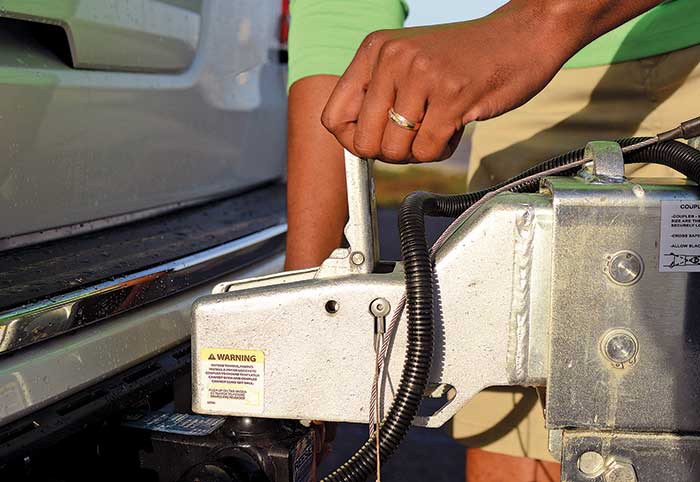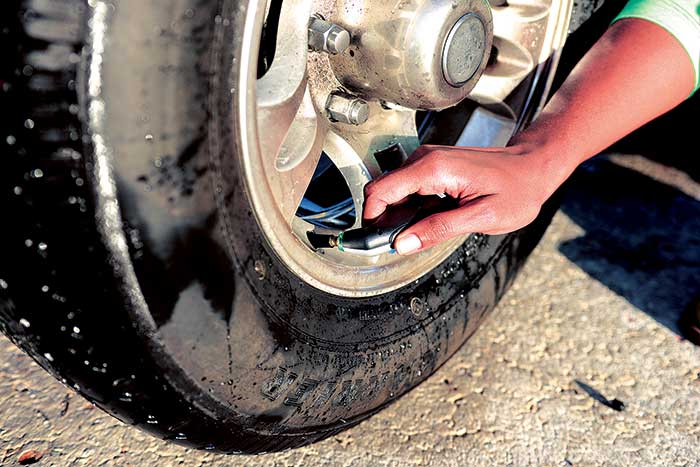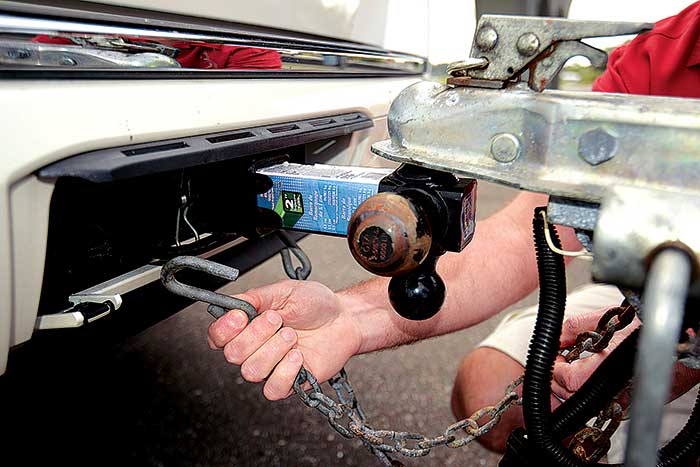Advertisement
Follow these steps and guidelines to ensure a safe and uneventful tow.

Before hitting the road, set your mirrors and make sure they are large enough to see your boat and trailer as well as the traffic around you. (Photos: Jason Arnold)
When a trailer and tow vehicle are set up properly and the driver uses the right precautions and drives defensively, towing a trailer can be reasonably free of untoward incidents. There are many thousands of experienced boaters — including yours truly, knock wood! — who've towed for decades and hundreds of thousands of road miles with little if any drama. Here's how it's done.
Preparation
There's no substitute for good prep before a towing trip. Even experienced trailering pros know that if something's off — if tire pressure is low, if a light is out on the trailer, if the driver didn't get enough sleep — it will put undue stress on the person behind the wheel. The key is to get the details right and minimize stress so you're able to handle unforeseen situations more capably. Start with the tow vehicle and trailer:
- Your tow vehicle and trailer should be matched properly. Don't overload the trailer or tow a load that's too much for your vehicle. (Read "Tow Capacity Math" to find out how much your vehicle can safely tow.)
- Your tow vehicle's hitch should be bolted securely to the frame, and it shouldn't be rusty or otherwise compromised.
- Your trailer's weight should be balanced fore-and-aft and side-to-side. The trailer's tongue weight should be between 5% and 10% of the gross trailer weight. If in doubt, measure it using a bathroom scale. (Read "Tongue Weight DIY" to learn how.)

Match the trailer and tow vehicle, and ensure the trailer weight is balanced.
- The cargo in your tow vehicle should be similarly balanced. If the rear of the vehicle and the tongue of the trailer are sagging, the entire package will handle poorly, steer badly, and sway dramatically.
- Your trailer's running gear should be prepped, ready, and working properly. This means the tires should have good tread, aren't weather checked or cracking, and are inflated to the correct pressure. Tire pressure is extremely important. Low tire pressure causes overheating of the tire sidewall and leads to failure. Check them before and during your trip. Carry a spare tire and jack and other equipment to change it. Consider purchasing a trailer tire monitor kit which can tell the driver tire pressure and temperature and warn of sudden deflation.

Tires should be inflated according to manufacturer recommendations.
- The wheel bearings and grease should be fresh and ready for the trip.
- The axle and springs should be in good shape and adequately support your boat. The trailer frame, bunk supports, and bunks should be solid and support the boat properly.

Check all trailer lights to ensure they’re working properly.
- The trailer lights should all work correctly and have a solid ground connection. Don't use the hitch ball as the ground!
- The trailer brakes, if your trailer has these, should be in operating condition. If your boat and trailer's total load dictates the need for brakes (3,000 pounds is generally the cutoff, but state laws vary) and yours are missing or not functional, then don't tow.
- If your trailer and tow vehicle are equipped with a brake controller (most rigs are not wired and configured to have this), the controller should be adjusted according to manufacturer's instructions.
- The winch, winch strap, tongue jack, and coupler should all be in good working order.
- The emergency breakaway cable should be unobstructed in its operation and attached at the appropriate place on the tow vehicle.
- The boat should be properly tied down with straps of adequate breaking strength.
- The boat should be retained with an emergency chain at the bow eye to keep it on the trailer should the winch and tie-down straps break.

Cross and connect the safety chains.
- The safety chains should be in good condition and adequately sized to hold the trailer should the coupler become detached. Cross the chains under the tongue and connect them securely to the tow hitch's safety chain loops. Length of chains should not be so short that you can't turn, or so long that they drag or won't be effective if the coupler becomes detached.
- If your rig is large enough to warrant it, consider having anti-sway and weight distribution equipment installed. (See "Anti-Sway And Weight-Distribution Hitches".)
- The outboard or outboard drive should be adjusted properly and resting on its stops.
- Last, but definitely not least, have side mirrors, either factory or added on, that are large enough for you to see your boat and trailer and still see the traffic around you. Adjust them for best all-round visibility before you drive. If your trailer and tow vehicle are equipped with a rear-view camera (most rigs are not wired and configured to have this) be sure that it is working properly.
Practice, Practice, Practice
If you've never towed a trailer or it's been a few seasons, you'll be far more confident if you spend time practicing before heading for the highway. Start in a large, empty parking lot, and have an experienced trailer-tower join you as co-pilot and instructor. You'll need plenty of wide-open space with few obstructions to feel comfortable. In this environment, you can drive slowly, focusing on how the tow vehicle acts with the trailer attached.
You can also detach the trailer and perform the same maneuvers to determine the differences between towing and not towing. When practicing, focus on these areas:
- Acceleration: Feel how the rig plus the trailer takes a lot longer to accelerate to speed than it does without the trailer.
- Braking: Similarly, the rig with trailer takes longer to slow down, requiring a lot more pedal pressure, than it does without the trailer.
- Turning: Turns must be made more slowly and deliberately with the trailer attached. Practice swinging wide at corners, so the inside wheel of the trailer doesn't hit the curb.
- Practice backing: Use the parking lines in the lot to practice steering in reverse.
- Stability: The truck will feel heavier and tippier with the trailer attached. As a result, sudden maneuvers, whenever possible, should be avoided.
- Length: The length of the trailer behind the truck must be constantly in your awareness, especially when you're overtaking slower traffic, turning, backing, maneuvering in such tight spaces as a gas station, and choosing a parking space. When backing, don't allow the trailer to turn too sharply.
- Turn signals: Apply earlier to warn others of your intent.
Parking Tips
Parking with a trailer can be challenging. Be careful to leave yourself enough room to maneuver and pull out while not taking up so much space that you're a nuisance. Pull over to the side, well out of the way of the traffic moving in and out. If you have to park on an incline, be sure to angle the rig and the front wheels so that if the transmission and/or parking brakes fail and the rig begins to move, it hits the curb and can't move farther. Chocking your wheels may be needed in some cases.
On The Road
After a parking-lot practice session or two, try some back roads. Choose roads less traveled and avoid rush hour. Practice merging into traffic by accelerating deliberately but firmly up the on-ramp and signaling early to move into traffic. Learn to keep a larger distance between you and the traffic ahead, as it will take your rig longer to slow down. Lastly, learn to drive slower with the trailer attached; if you normally drive at the speed limit, slow by 5 mph or so when towing. Until you become very comfortable and have gained experience over several towing trips, don't engage the cruise control when towing, and many say to not engage it at all. Read your tow vehicle's manual on towing. Your reaction time in challenging situations is critical. Most tow vehicle manufacturers suggest engaging the Towing Mode switch, if available.
Reacting
Towing is a lot like dealing with large, wild animals: No sudden movements allowed. Your typical driving reactions won't work when you're towing a boat on a trailer. Here's how to react when confronted by these sudden surprises:
- Abrupt lane change or braking directly ahead: Lay off the gas immediately and, if possible, gently tap the brakes to induce a slowdown without swerving or causing instability.
- Flat tire or broken suspension or spring: If possible, avoid stomping suddenly on the brakes. Deliberately steer to the shoulder and apply the brakes gently, if at all. Use your hazard flashers to warn other drivers.
- Tongue/coupler failure: Again, no sudden braking. Steer firmly but slowly to the shoulder.
- Trailer swaying or instability: Apply very little steering input while letting off the gas; don't brake heavily, as this will make the condition worse. In some cases, light fuel pedal pressure will alleviate the sway.
Advertisement
- High winds and passing vehicles: These conditions can induce or worsen trailer sway. Again, apply very little steering input, and slow down gradually without applying the brakes. Remember when passing and pulling back into the lane that your rig is much longer than just the truck.
- Steep uphill grades: Move to the right lane to allow faster vehicles to pass, if you weren't driving in it already. Use a lower gear to keep engine RPM steady and engine and transmission temps in check. Depending on rig and tow vehicle, this gear may need to be used throughout the tow. Downshift as needed.
- Steep downhill grades: Such descents, especially those that end in T intersections, can be tricky and nerve-wracking. Start by approaching the hill slowly; decrease speed before you begin descending. If it's not already there, drop the transmission to a lower gear (or "trailer tow" gear if you have it) to allow the engine to keep the speed in check. Don't apply constant brake pressure until it's absolutely needed, usually at the bottom of the hill, as this prematurely heats up the brakes, rendering them less effective. Rather, apply the brakes periodically but firmly, releasing them every few seconds to allow some cooling.
Planning Your Trip
Plan your route ahead of time so fuel and rest stops can be free of stress and you spend less time worrying about where your rig will fit when you stop. Remember to keep farther back when following traffic. Don't hog the passing lane; stay in the slower lanes unless you're overtaking traffic.
Of course, it should go without saying: no texting, no web surfing, and no talking on the cellphone while you're towing. In many jurisdictions this is unlawful. Keep the radio turned low so you can hear any potential trailer noises and can focus more clearly on driving, towing, and the road around you. Pay attention to nearby drivers, and take frequent looks at them in case they're trying to signal you about such trailer trouble as a smoking tire, a light out, swaying, and the like.
